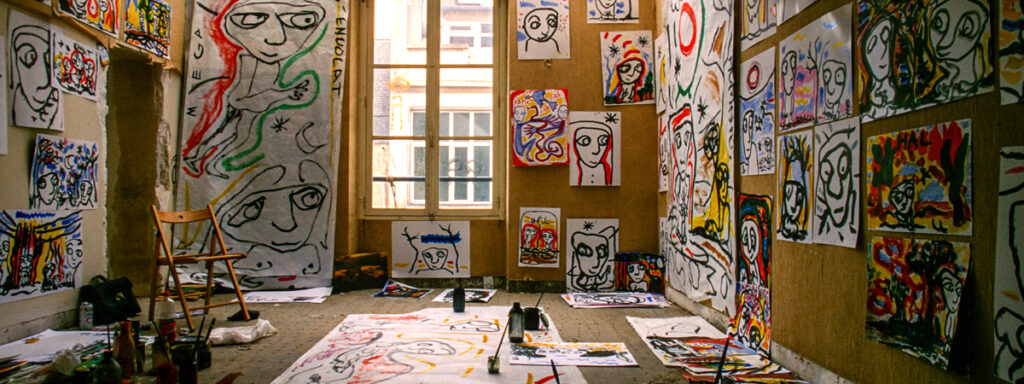Are you ready to take your creative career to the next level? Picture this: You’ve poured your heart and soul into your art, honing your skills, refining your style, and creating breathtaking masterpieces that deserve to be seen by the world. But there’s just one problem – your online presence is lacking. Your portfolio is scattered across various platforms, buried beneath a sea of other artists vying for attention. Sound familiar? Don’t worry – you’re not alone.
In today’s hyper-connected world, having a stunning online presence is essential for any artist looking to make their mark. Your portfolio is more than just a collection of your best work – it’s your digital calling card, your virtual storefront, and your ticket to success in the competitive world of digital art.
But where do you start? How do you create a portfolio that truly showcases your talent and sets you apart from the crowd?
In this article, we will dive deep into the art of building a stunning online presence for your digital art. From choosing the right platform to crafting a compelling artist statement, curating your best work to optimizing for visibility, we’ll cover everything you need to know to create a portfolio that wows.
So if you’re ready to elevate your art career, attract more clients, and showcase your talent to the world, you’re in the right place. Get ready to unlock the secrets to building a stunning online presence and take your art to new heights!
Table of Contents
- Setting the Foundation: Crafting Your Digital Art Space
- Curating Your Best Work: Quality Over Quantity
- Designing Your Online Space: Making Your Portfolio Pop
- Optimizing for Visibility: Getting Your Portfolio Seen
- Engaging Your Audience: Building Connections Through Your Portfolio
- Maintaining and Updating: Keeping Your Portfolio Fresh
- Conclusion
Setting the Foundation: Crafting Your Digital Art Space

Choosing the Right Platform
First things first, let’s talk about platforms. When it comes to showcasing your digital art or traditional art online, you’ve got options galore.
From dedicated portfolio websites like Behance and ArtStation to more customizable solutions like WordPress or Squarespace, the choice is yours.
I’ve found that platforms specifically tailored to artists offer the best balance of functionality and aesthetics.
Selecting the Best Longtail Keyword Phrase
Now, let’s talk SEO – that’s Search Engine Optimization for the uninitiated. It’s the secret sauce that helps your portfolio get discovered by the right people. And one of the most important ingredients? Your longtail keyword phrase.
For this article, “creating a digital art portfolio” hopefully brought you here. It’s specific enough to attract folks looking for exactly what I’m writing about, but not so niche that it’s impossible to rank for.
Crafting a Compelling Artist Statement
Ah, the artist statement – the bane of many creatives’ existence. But fear not! Crafting a compelling artist statement is easier than you think.
Think of it as your elevator pitch – a concise yet captivating summary of who you are, what you do, and why you do it.
And don’t be afraid to inject a bit of your personality into it! After all, your art is an extension of yourself.
Curating Your Best Work: Quality Over Quantity
Selecting Your Portfolio Pieces Strategically
When it comes to curating your portfolio, less is often more. Instead of bombarding your visitors with every piece of art you’ve ever created, focus on showcasing your best work.
Think of it like curating an art exhibition – you want each piece to complement the others and tell a cohesive story.
I like to think of my portfolio as a highlight reel of my artistic journey – a snapshot of my evolution as an artist.
Showcasing Diversity
Variety is the spice of life – and the key to a compelling portfolio. Instead of sticking to one style or subject matter, don’t be afraid to show off your versatility as an artist.
Whether it’s experimenting with different techniques, exploring new themes, or pushing the boundaries of your chosen medium, diversity is what keeps your portfolio fresh and exciting.
Plus, it shows potential clients and collaborators that you’re not afraid to take risks and think outside the box.
Tailoring Your Portfolio to Your Audience
Know thy audience. It’s a mantra that’s as old as time – and for good reason. Understanding who you’re trying to reach with your portfolio is crucial to its success.
Are you targeting fellow artists, potential clients, or gallery owners? Each audience has its own unique needs and preferences, so tailor your portfolio accordingly.
For example, if you’re hoping to attract freelance gigs, highlight projects that showcase your ability to deliver on time and budget.
If you’re angling for gallery representation, focus on pieces that demonstrate your artistic vision and technical skill.
Designing Your Online Space: Making Your Portfolio Pop
Design Principles for Artists
As artists, we’ve got a leg up when it comes to design – after all, visual storytelling is our bread and butter. But when it comes to designing your online portfolio, there are a few key principles to keep in mind.
- Visual hierarchy, for example, helps guide your visitors’ eyes through your portfolio, highlighting the most important elements and minimizing distractions.
- Color theory can evoke emotion and set the mood for your portfolio, while typography can add personality and flair.
- And don’t forget about whitespace – it’s the unsung hero of good design, providing breathing room for your art to shine.
User Experience Considerations
User experience, or UX for short, is all about making sure your visitors have a seamless and enjoyable experience navigating your portfolio. Think of it as the difference between wandering through a cluttered maze and strolling through a beautifully curated art gallery.
Make sure your portfolio is easy to navigate, with intuitive menus and clear calls to action.
Also, don’t overlook the importance of responsiveness – your portfolio should look and function flawlessly across devices, from desktops to smartphones and everything in between.
Incorporating Multimedia Elements
Who says your portfolio has to be static? Incorporating multimedia elements like videos, process shots, and interactive features can take your portfolio to the next level.
For example, why not create a timelapse video of your creative process, or add interactive sliders that let visitors compare different versions of the same piece?
The sky’s the limit when it comes to multimedia – so get creative and think outside the box!
Optimizing for Visibility: Getting Your Portfolio Seen
Harnessing the Power of SEO
SEO – the holy grail of online visibility. By strategically incorporating keywords like “digital painting” throughout your portfolio, you can improve your chances of ranking higher in search engine results.
But remember – it’s not just about stuffing your portfolio full of keywords.
You want to strike the right balance between SEO and readability, ensuring that your portfolio is both search engine-friendly and user-friendly.
Leveraging Social Media
Social media is a powerful tool for getting your work in front of a wider audience.
Whether it’s Instagram, Twitter, or TikTok, each platform offers its own unique opportunities for showcasing your portfolio and connecting with fellow artists and art lovers.
Don’t be afraid to get creative with your social media strategy – from behind-the-scenes peeks to work-in-progress shots, the more personality you inject into your posts, the better.
Networking and Collaborations
Lastly, don’t underestimate the power of networking and collaborations.
Building relationships within the creative community can open doors you never knew existed, whether it’s landing a coveted spot in a group exhibition or snagging a high-profile commission.
So get out there, attend art events, join online forums, and don’t be afraid to reach out to fellow artists whose work you admire. You never know where it might lead!
Engaging Your Audience: Building Connections Through Your Portfolio
Encouraging Interaction
Your portfolio shouldn’t be a one-way street – it should be a conversation.
Encourage interaction by incorporating features like comments, likes, and shares, allowing visitors to engage with your work on a deeper level.
After all, art is meant to be experienced, shared, and discussed – so why not invite your audience to join the conversation?
Providing Context
Behind every piece of art lies a story – and your portfolio is the perfect place to share it.
Whether it’s the inspiration behind a particular piece, the techniques you used to bring it to life, or the challenges you faced along the way, adding context can enrich your audience’s understanding and appreciation of your work.
Plus, it humanizes you as an artist, making you more relatable and approachable in the eyes of your audience.
Collecting Feedback
Last but not least, don’t forget to collect feedback from your audience.
Whether it’s through surveys, polls, or good old-fashioned comments, listening to what your audience has to say can provide invaluable insights into what’s working – and what’s not – in your portfolio.
Plus, it shows that you value your audience’s opinion and are committed to continuously improving and evolving as an artist.
Maintaining and Updating: Keeping Your Portfolio Fresh
Regularly Updating Your Portfolio
A portfolio is a living, breathing entity – it should evolve and grow along with you as an artist.
That means regularly updating it with your latest and greatest work, while also pruning away the pieces that no longer reflect your current style or skill level.
Think of it as spring cleaning for your portfolio – a chance to tidy up and make room for new opportunities and adventures.
Keeping Your Site Secure and Functional
In today’s digital age, cybersecurity is more important than ever. Make sure your portfolio is secure and functional by keeping your software up to date, implementing strong passwords, and backing up your files regularly.
After all, the last thing you want is for your portfolio to be hacked or corrupted, putting all your hard work and creative energy at risk.
Evolving with Your Art
Last but not least, don’t be afraid to let your portfolio evolve along with your art. As artists, we’re constantly growing, learning, and experimenting – and your portfolio should reflect that journey.
Don’t be afraid to take risks, try new things, and push the boundaries of your creativity. After all, isn’t that what being an artist is all about?
Final Thoughts
And there you have it – a crash course in building a stunning online presence for your digital art. From choosing the right platform and crafting a compelling artist statement to optimizing for SEO and engaging your audience, there’s a lot to consider – but don’t let that overwhelm you.
Remember, your portfolio is a reflection of who you are as an artist – so let your unique voice and vision shine through. Now go forth and conquer the digital art world – your audience is waiting!



